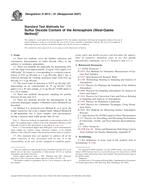We need your consent to use the individual data so that you can see information about your interests, among other things. Click "OK" to give your consent.
ASTM E2267-04(2013)
Standard Guide for Specifying and Evaluating Performance of Single Family Attached and Detached Dwellings—Indoor Air Quality (Withdrawn 2022)
Automatically translated name:
Standard Guide for Specifying and Evaluating Performance of Single Family Attached and Detached Dwellings—Indoor Air Quality
STANDARD published on 1.1.2013
The information about the standard:
Designation standards: ASTM E2267-04(2013)
Note: WITHDRAWN
Publication date standards: 1.1.2013
SKU: NS-44857
The number of pages: 17
Approximate weight : 51 g (0.11 lbs)
Country: American technical standard
Category: Technical standards ASTM
The category - similar standards:
Annotation of standard text ASTM E2267-04(2013) :
Keywords:
building performance, indoor air pollution, indoor air quality, residential, ventilation, ICS Number Code 13.040.20 (Ambient atmospheres)
Additional information
| Significance and Use | ||||||||||||||||||||||||||
|
4.1 General Purpose and Intent : 4.1.1 This guide is to provide a standardized system for describing performance parameters of single-family attached and detached dwellings. The use of consensus performance standards for housing, can significantly contribute to the removal of barriers to the acceptance of traditional and innovative housing products and systems in the global marketplace. This guide in conjunction with the balance of the set of standard guides can also serve to improve communications between producers and consumers leading to enhanced quality and performance of housing. 4.1.2 This guide, in conjunction with the balance of the set of standard guides, will be useful to managers of housing procurement projects, homebuilders, designers, product manufacturers, and evaluation services. 4.2 Indoor Air Quality Issues: 4.2.1 The environment within a building impacts the health of the building occupants and their satisfaction with the space. While this guide only addresses indoor air quality, this aspect of the indoor environment is an important component of a performance approach to residential buildings. 4.2.2 The performance statements contained in this guide are relevant to the procurement of a range of built elements related to the indoor environment, including but not limited to the whole building, the exterior enclosure, HVAC subsystems, local exhaust subsystems, other ventilation subsystems and their components, filtration and air cleaning subsystems, and building materials and furnishings. |
||||||||||||||||||||||||||
| 1. Scope | ||||||||||||||||||||||||||
|
1.1 This guide contains suggested performance statements for single family residential buildings (attached and detached) that address indoor air quality performance including indoor air pollution and thermal comfort. These performance statements are not presented as proposed requirements, but are written in permissive language as suggestions that can be used in developing specifications to satisfy user needs. 1.2 This guide does not address other aspects of the indoor environment such as lighting and acoustics. 1.3 Performance statements addressing building ventilation and ventilation rates are also included in the standard, since it is premature to base performance only on indoor air pollution, that is, airborne contaminant concentrations. When health authorities have established contaminant concentration limits for residential environments, it may be possible to define indoor air quality performance in terms of contaminant concentrations rather than ventilation. 1.4 This guide is one in a series of guides containing performance statements for residential buildings that are intended for use in the procurement, specification and evaluation of one- and two-family dwellings. These companion standard guides include those noted in the Introduction above. 1.5 This guide also addresses a number of residential indoor air quality issues that can not be expressed as performance statements at this time. However, they are important enough to include in this guide to at least raise the awareness of those involved in the process of procurement, specification and evaluation. These issues are addressed in 1.6 This guide does not include site planning objectives. However, certain issues addressing the relationship of building to site have been covered, and it is important that these few objectives not be construed as a comprehensive site specification. 1.7 This standard does not purport to address all of the safety concerns, if any, associated with its use. It is the responsibility of the user of this standard to establish appropriate safety and health practices and determine the applicability of regulatory requirements prior to use. |
||||||||||||||||||||||||||
| 2. Referenced Documents | ||||||||||||||||||||||||||
|
Similar standards:
Historical
1.10.2011
Historical
1.10.2010
Historical
1.9.2014
Historical
1.10.2010
Historical
1.4.2007
Historical
1.4.2007
We recommend:
Technical standards updating
Do you want to make sure you use only the valid technical standards?
We can offer you a solution which will provide you a monthly overview concerning the updating of standards which you use.
Would you like to know more? Look at this page.



 ASTM D1607-91(2011)..
ASTM D1607-91(2011).. ASTM D1739-98(2010)..
ASTM D1739-98(2010).. ASTM D1914-95(2014)..
ASTM D1914-95(2014).. ASTM D2010/D2010M-98..
ASTM D2010/D2010M-98.. ASTM D2913-96(2007)..
ASTM D2913-96(2007).. ASTM D2914-01(2007)..
ASTM D2914-01(2007)..
 Cookies
Cookies
